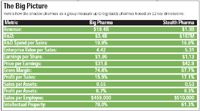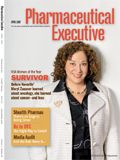Stealth Pharmas
Pharmaceutical Executive
Ever wonder how all those biotechs, specialty shops, and generics that make up Not Big Pharma ever manage to stay in business? Pharm Exec asked Bill Trombetta of St. Joseph's University to look at their books, analyzing their financial performance with the same metrics he uses for our annual Industry Audit. His findings may surprise you. In fact, when you check the bottom line, you just might consider changing teams.
Ever wonder how all those biotechs, specialty shops, and generics that make up Not Big Pharma ever manage to stay in business? Pharm Exec asked Bill Trombetta of St. Joseph's University to look at their books, analyzing their financial performance with the same metrics he uses for our annual Industry Audit. His findings may surprise you. In fact, when you check the bottom line, you just might consider changing teams.

Not Big Pharma
Legend has it that F. Scott Fitzgerald and Ernest Hemingway were once trading boozy barbs when the fatally romantic Fitzgerald observed, "The rich are different from you and me." "Yes," the suicidally cynical Hemingway answered. "They have more money."

The Big Picture
And so it is with Big Pharma. Big Pharma is different from the thousands of biotechs, specialty pharmas, generics makers, and other companies that make up what we call, for lack of a better term, Not Big Pharma. Yes, they have more money. But in what other ways are they different? And can we learn anything from the way Not Big Pharma competes?

Revenue
First, let's dignify them with an identity of their own. I call them "Stealth Pharmas" because they fly under the radar: Everyone knows who these companies are, but no one has ever rounded them up and analyzed how they compete in comparison to the big guys. As a category, Stealth Pharma simply encompasses everything that is not Big Pharma: biotechs, specialty pharmas, generic firms, diagnostics, and drug-delivery firms. As individual companies, they grow increasingly difficult to label: Many started out as a biotech or a generic-drug maker but, by seizing opportunities, have morphed into hybrid entities. Call them wild cards.

Enterprise Value

R&D
I made a random selection of 15 that fit my two criteria: They had to be, to some extent, in the public eye, covered in the pharmaceutical trade journals and business press, and they had to have made a profit in 2005—which, of course, narrowed the selection considerably. But there is no attempt here to measure, compare, and score performance to come up with a winner or even a ranking of the "Stealth 15" (as we do in the annual "Industry Strategic Audit" every September in Pharmaceutical Executive). Our aim is much more modest: how do these 15 shadow pharmas stack up against Big Pharma?
Let's begin.
OVERVIEW OF METRICS
The first thing to notice is how, as a group, the Stealth Pharmas stack up against Big Pharma (the top 15 companies listed in Pharm Exec's Industry Audit last year):

Enterprise value/sales

Earnings Per Share
"The Big Picture" compares the Stealths to the major pharmas along 12 key dimensions:
For Pharm Exec's "Industry Audit" Top 15, the average revenue for 2005 was $18.4 billion; for the Stealths, the average revenue was much lower: $1.34 billion.
The top pharmas spent, on average, about $3.4 billion on R&D in 2005, while the Stealths spent about $157 million—no surprise, given the differences in scale.
But R&D-spend-to-sales ratios were almost equivalent: Big Pharma doled out almost 20 percent of revenues on R&D to the Stealths' near 17 percent. Enterprise value—or the value of a company if one were to purchase it (market capitalization plus debt minus cash)—is quite different. Reality check: Arguably the most valuable of the 5,000 or so Stealths out there is Teva, at almost $25 billion in enterprise value (EV) as of September 2006; Pfizer, the industry leader, is capitalized at well over $200 billion (see "Enterprise Value"chart).

Price/Earnings

R&D spend/sales
But when it comes to the normalizing ratio of EV to sales, the 15 Stealths selected here are valued, on average, higher: 5.31 to 4.42 for Big Pharma. This tells us that growth and profitability are likely to be found more with the Stealths than with their bigger brethren, at least right now.
As for other interesting dimensions, Big Pharma wins the earnings-per-share multiple ($1.86), while the Stealths nab the price-to-earnings crown ($42.9).
Gross margin is significantly higher for Big Pharma, indicating its ability to price higher with more branded drugs. So is profit-per-sales: 17.1 percent for the Big Pharmas compared to Stealth's 15.9 percent. But even with lower prices, the Stealths do a good job of managing profit margin and costs, which are arguably much lower for R&D and marketing expenses.

Gross Margin
The sales-to-assets ratio is about equal with .55 for Big Pharma and .53 for the Stealths—it takes about a dollar in assets to produce about 50 cents in revenue. And this evens out the important metric of profit to assets, with each around 8.5 percent.
The Stealths are more productive in terms of sales per employee at $510,000 compared to Big Pharma at $459,000.
Not surprisingly, intellectual property capital gives the edge to Big Pharma (78.0 percent vs. 61.3 percent). In other words, about 80 percent of a Big Pharma's income is driven by intellectual property and innovation compared to about two-thirds of a Stealth's.

Profit/sales
This 12-metric overview illustrates that the Stealths are worthy competitors and know how to conduct business.
STEALTH METRICS UP CLOSE
Revenue Teva is the giant in sales revenue at over $5 billion. This pales to Pfizer's $50 billion or GSK's $40 billion, but it's worth noting that in terms of scrips, Teva is the world leader with some 400 million last year. But high prices often trump high volume, which is one reason that Teva is moving fast to develop branded generics.

Sales/Assets
Enterprise Value to Sales This is arguably the most important metric: It shows how valuable a company's future prospects are: growth, profitability, and innovation. And Celgene is at the head of the Stealth Pharma class for 2005. With its new IMiDs, it has a virtual exclusivity for a rare form of cancer at a very low cost of production.
Gross Margin This metric is calculated by subtracting the cost of products sold from total sales. Note how strong Celgene and Allergan are on pricing power—two small firms that make high-priced drugs for niche markets.

Profit/Assets
Profit/Sales, Sales/Assets, Profit/Assets These three charts, taken together, concern management of profit-to-sales ratio (margins) or sales-to-assets ratio (assets). They are related because they result in a very important performance metric: return on assets. On that score, kudos to Endo and Barr. Both are relatively strong in both margin and asset management, earning them a ranking of number one and two, respectively, on profit per assets. It is difficult enough to do well on one of these metrics, but doing so on two is exceedingly rare and truly makes a company a double threat.
Sales per Employee This metric is essentially a measure of productivity. Again, Endo's employees packed the most punch for 2005, with Barr coming in at number four. Note the disparity between King at number three at $630,000 per employee and Mylan at number 10 at $420,000 per employee, an indication that the one-time proposed merger between the two might have resulted in quite a culture clash.

"Smart" Sales
"Smart" Sales This new metric measures the percentage of sales driven by intellectual property or innovation. Once again, Endo and Barr are near the top, showing that these companies are strong on the ability to drive earnings from intellectual property and innovative ways of doing business. And note: Intellectual property does not refer simply to patents and pipelines, but to innovations of all kinds, including new technology, new systems, and new processes. (The sales-from-intellectual-property-assets metric relies on the methodology of Professor Lev Baruch, an accounting professor at Baruch University in New York. For a description of his approach to valuing intellectual property and innovation, see "Industry Audit," Pharmaceutical Executive, September 2006.)

Sales per Employee
HEAD TO HEAD ON PROFITS
How can companies like Teva, Barr, Watson, and other "generics," with their reliance on low pricing, ever turn a profit? That question once was voiced frequently. But a glance at the comparison chart, "Brands vs. Biotechs vs. Generics" (below), reveals that yes, Virginia, the generics are in the same league as Big Pharma when it comes to making money.
The companies that produce knockoffs are, on average, only 4 percentage points lower on profit to sales than their branded proprietary "betters." Two reasons: less expense on R&D (duh!) and lower operating expenses, particularly, in marketing and sales. That situation is likely to change as the Stealths move into branded drugs and increasingly need to market directly to physicians.

Brands vs. Biotechs vs. Generics
Just how profitable the Stealths can be is illustrated by Barr's six months' exclusivity on generic Prozac in 2003. As Gardiner Harris and Joanna Slater reported in a Wall Street Journal piece, the generics maker had sales of about $350 million—and, given a 20 percent profit margin, raked in some $70 million on the antidepressant. Its only major cost was the money spent on lawyers to break Lilly's Prozac patent—not a bad return on investment.
Another example is Andrx's launch of Cartia XT, or generic Cardizem CD. According to In Vivo's Wendy Diller, for six months, Andrx had no competition, making profits of $64 million on sales of $200 million, a 30 percent profit margin—which ranks with any of the Big Pharmas in terms of profit to sales.
NO ONE-SIZE-FITS-ALL MODEL
The Stealths are not, of course, applying the blockbuster model. Their basic expertise is not in R&D but in S&D: "search and develop." They find underappreciated drugs and put marketing muscle behind them. They are good at improving efficacy, convenience and side effect profiles. They get to market faster with less investment. They can focus on smaller target markets: buyers of drugs for pharmacies and managed care organizations.
As for the superstar Stealths, they are certainly deploying the strategy of market segmentation artfully. Do the numbers: Allergan, which competes in markets like dermatology, aesthetics, and ophthalmology, is growing at 25 percent a year or more. That's a bottom line sure to make Wall Street nostalgic for Big Pharma's good old days, before its current sales growth slumped into the single digits.
Bill Trombetta is professor of pharmaceutical marketing and strategy at the Erivan K. Haub School of Business at St. Joseph's University in Philadelphia. He can be reached at dtrombet@aol.com

The Misinformation Maze: Navigating Public Health in the Digital Age
March 11th 2025Jennifer Butler, chief commercial officer of Pleio, discusses misinformation's threat to public health, where patients are turning for trustworthy health information, the industry's pivot to peer-to-patient strategies to educate patients, and more.
Navigating Distrust: Pharma in the Age of Social Media
February 18th 2025Ian Baer, Founder and CEO of Sooth, discusses how the growing distrust in social media will impact industry marketing strategies and the relationships between pharmaceutical companies and the patients they aim to serve. He also explains dark social, how to combat misinformation, closing the trust gap, and more.

.png&w=3840&q=75)

.png&w=3840&q=75)



.png&w=3840&q=75)



.png&w=3840&q=75)






















